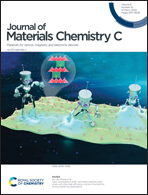Dual Eu-MOFs based logic device and ratiometric fluorescence paper microchip for visual H2O2 assay†
Abstract
Hydrogen peroxide (H2O2) is a typical reactive peroxide that is widely used in food preservation but may cause serious harm to human health. Thus, a simple, efficient and accurate method for H2O2 assay is essential. In this work, a dual Eu-MOFs-based ratiometric fluorescence sensor, a logic gate-based advanced analytical method, and a dual MOFs-loaded paper microchip for visual H2O2 assay were constructed. The H2O2 sensor was response-sensitive (limit of detection: 0.14 μM) and linearly responsive in the concentration range of 0.001–1 mM (r > 0.99). Then, an advanced AND gate logic device was established to monitor H2O2 concentration. Moreover, the paper-based microchip realized the point-of-care visual H2O2 assay via ratiometric chromaticity assisted by a portable smartphone-based visual assay device. The microchip consumes only 5 μL of sample and demonstrates long-term stability for over 30 days along with response-sensitivity. Both the MOF dispersion-based ratiometric fluorescence sensor and the paper microchip realized an accurate and precise assay of H2O2 (the recovery was 88.2–105.5% and RSD < 9.3%). To the best of our knowledge, this is the first report of a dual MOFs-based ratiometric fluorescent H2O2 sensor, an advanced logic gate-based analytical method, and a paper-based microchip for visual point-of-care H2O2 assay.



 Please wait while we load your content...
Please wait while we load your content...